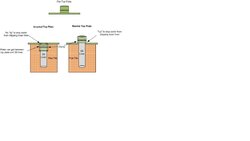I posted earlier today about leaking that is occurring during rain storms in our chimney. The installer is giving us the "run around" so then i began to think about how it was installed. When he installed the liner, he used a flat top plate and turned it upside down, so the clamp was "inside" the flu tile area. He then silicone or epoxied it to the top of the flu tile. He did this because of clearance with the multi flu cap. I figured this was fine not really thinking about it.
However when it is inverted, it is effectively a flat plate over top of the flu tile (mine is 12"x12") with a 6" hole in the middle for the liner. Even though there is a multi flu cap on my chimney, when water gets on this "flat" surface (i.e. wind, splashing), where does it go? I am speculating that some of the water finds its way down the 6" hole in the middle. In the case of an inverted installation, the SS liner slided inside the flat plate collar and then it tightened down by the clamp. There is not a weather tight seal made beween the collar of the top plate and the SS liner. Is it possible and likely water will find its way down between the collar and the liner, dripping all the way down the liner and on to the top of the stove?
When the flat top plate is installed normal way up, the collar sticks up and the liner sides through it with the clamp on the top. With this setup, flat surface of the top plate has a 6" collar sticking up an inch or two. Therefore, when water collects on the flat part of the plate it "has" to run off the side, and can not run down liner.
I attached a sketch to try to illustrate my concern with the inverted top plate concern. Please let me know your thoughts.
Here is a link to my other post with the rust that occured from the water getting in.
https://www.hearth.com/econtent/index.php/forums/viewthread/79650/
However when it is inverted, it is effectively a flat plate over top of the flu tile (mine is 12"x12") with a 6" hole in the middle for the liner. Even though there is a multi flu cap on my chimney, when water gets on this "flat" surface (i.e. wind, splashing), where does it go? I am speculating that some of the water finds its way down the 6" hole in the middle. In the case of an inverted installation, the SS liner slided inside the flat plate collar and then it tightened down by the clamp. There is not a weather tight seal made beween the collar of the top plate and the SS liner. Is it possible and likely water will find its way down between the collar and the liner, dripping all the way down the liner and on to the top of the stove?
When the flat top plate is installed normal way up, the collar sticks up and the liner sides through it with the clamp on the top. With this setup, flat surface of the top plate has a 6" collar sticking up an inch or two. Therefore, when water collects on the flat part of the plate it "has" to run off the side, and can not run down liner.
I attached a sketch to try to illustrate my concern with the inverted top plate concern. Please let me know your thoughts.
Here is a link to my other post with the rust that occured from the water getting in.
https://www.hearth.com/econtent/index.php/forums/viewthread/79650/


